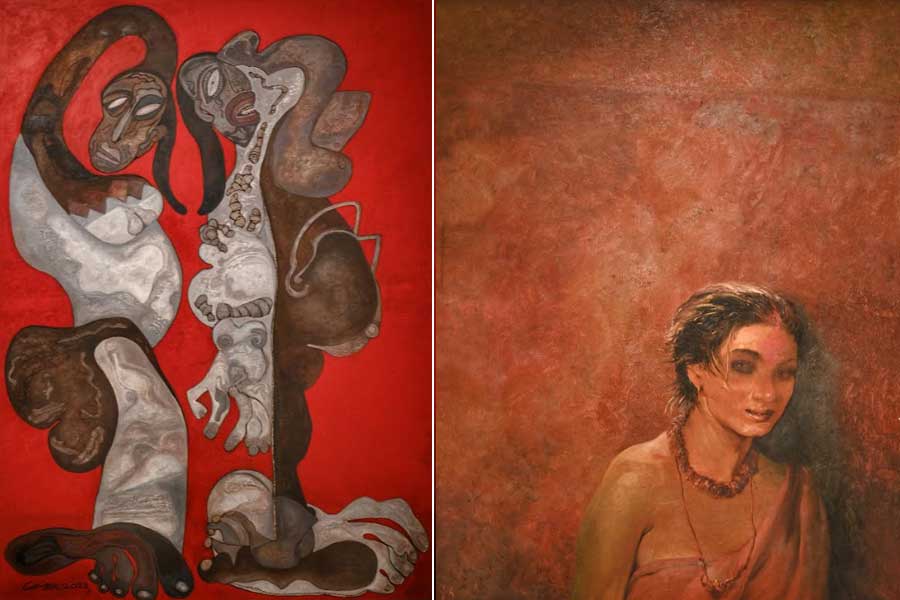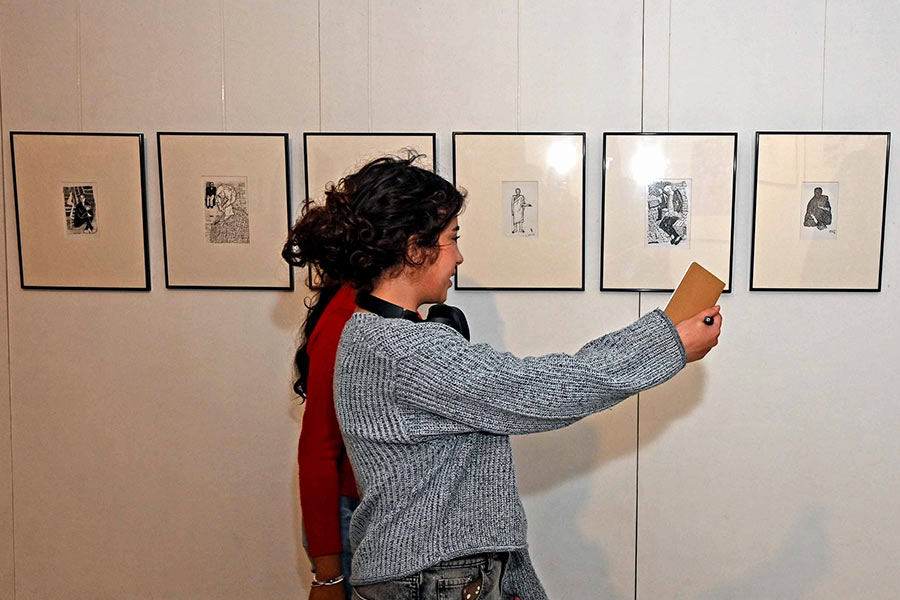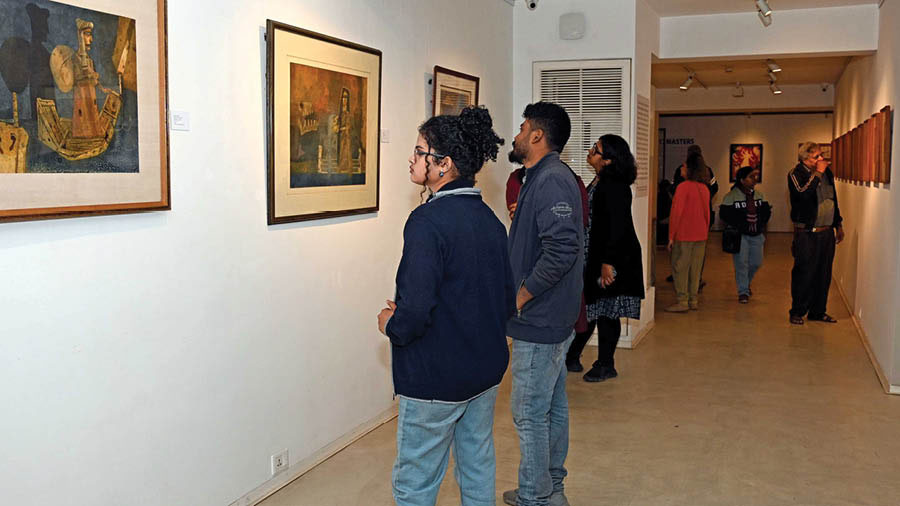Where Phase One of the CIMA 30th anniversary show was titled ‘From Fantasy to the Subliminal’, showcasing Ganesh Pyne, Arpita Singh, Shreyasi Chatterjee and Sushen Ghosh, the second tranche segued into the theme of ‘Neo Realism and Social Realism’. It features artists like Bikash Bhattacharjee, and his magic realism, while Jaya Ganguly, Jogen Chowdhury and Meera Mukherjee could be seeing from the point of neo realism. Giving aficionados a fresh chance to seek, find, and be sated with many works that have not been in the public domain, sourced as they have been from private collections including CIMA’s own. And seeing with fresh eyes our living stalwarts, far apart though they may be in age and styles, but knit by a societal verismo.
Phase Two in focus
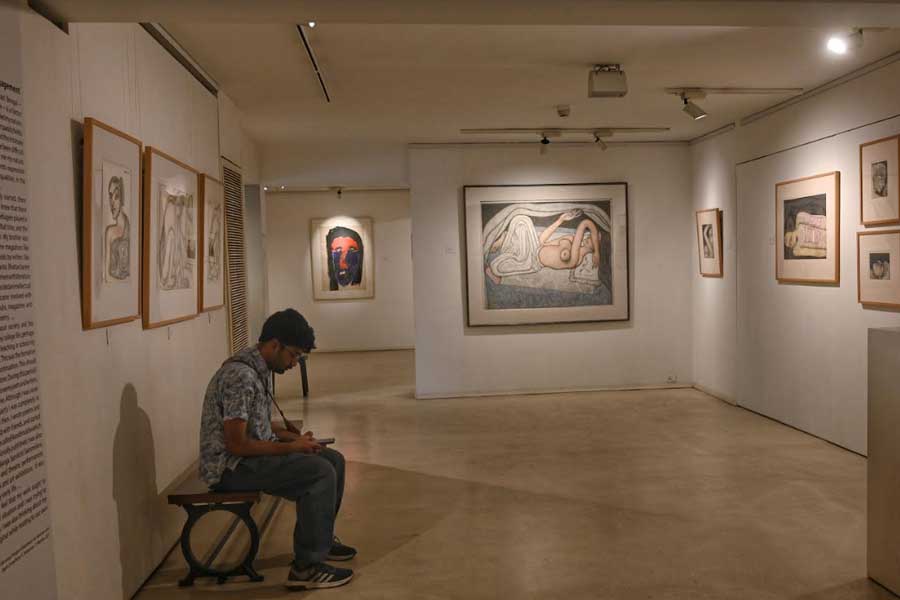
Phase two of the ’12 Masters’ exhibition at CIMA Gallery, titled ‘Neo Realisem and Social Realism’ feature artists Bikash Bhattacharjee, Jaya Ganguly, Jogen Chowdhury and Meera Mukherjee
As the exhibition will be concluding on March 1, we are taking the liberty of guiding those who have not yet had a chance to view this eclectic collection in the manner of a walkthrough. The curating of the varied approaches and innovative processes bound by the thread of realism can be daunting; yet it has created a palpable curiosity. As has been evident from the moment you enter the gallery and are confronted by a magnificent, but disturbing diptych by Jaya Ganguly, done in 2009, after her mother’s passing and an epitomized innocence by Bikash Bhattacharjee, an oil on canvas of a woman with a bunch of Kadam flowers, titled ‘Badal O Diner O Pratham Kadam Phul’. And right there, a pristine watercolour of flowers in a vase dating back to 1960.
The works of Bikash Bhattacharjee
And thence is a journey through the work of Bikash Bhattacharjee, whose academic brilliance, his intellectual gravitas and his masterful empathetic portrayals from pen and ink to his vast canvases – can be seen in the microcosm of the artspace. There are his portraitures of well of our familiar iconic figures — from Tagore and Swami Vivekananda, Sambhu Mitra and Rabi Ghosh to Indira Gandhi with the blood red garland and his own self-portrait with surrealistic head detached.
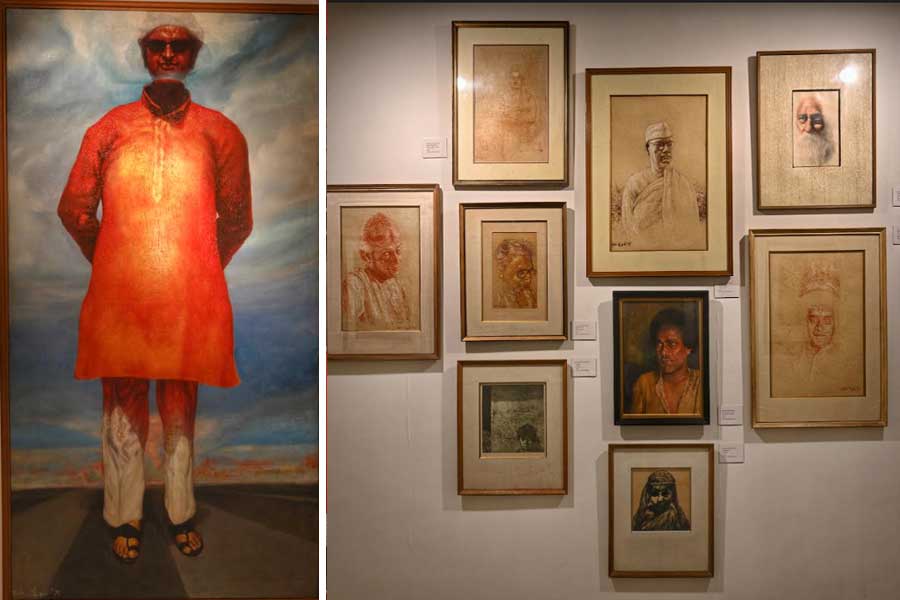
Portraits of greats and a self-portrait by Bikash Bhattacharjee
We are then able to view the story of Ramkinkar Baij, iconic sculptor, painter and graphic artist, done through extensive illustrations by Bikash Bhattacharjee for Samaresh Basu’s novel Dekhi Nai Phirey, first serialised in the Bengali literary magazine Desh. For this, Bikash had to divert his focus on rural Bengal, living there for long periods, understanding the psyche and struggles and even ostracism of Ramkinkar Baij, to his ultimate successes. Done through a vast series of illustrative work in mixed media on paper — a representational selection at the gallery capturing his mastery.

A work by Bikash Bhattacharjee
There is one canvas from his Doll series, which happened during the Naxalite period, when a discarded doll became the protagonist and a “voyeur and chronicler of a generation — misguided, hurt, abused and finally discarded as a hapless victim of its times,” says Rakhi Sarkar, Director of CIMA.
At the far end is the dramatic, disturbing, marginalised Jalil’s family, depicted in a haunting blue.
Sculptures by Meera Mukherjee

Meera Mukherjee’s innovation and her deep observation of the everyday lives of people in rural communities are reflected in her sculpted works
We come upon the sculptural masterpieces of Meera Mukherjee, which have been chosen for their compact, but intense portrayals. A niche selection, focusing on her bronzes, from the intense ‘Wood Gatherer’, ‘Ganga’ and ‘Kobi Sukanta Reading a Book’, an exquisite ‘Benares Ghat’, ‘Water Bearers’, ‘Paltola Nouka’ to the sculpted ‘Woman Breaking Husk’, replete with energy and empowerment. Thus it is that the neo-realism can be seen in her immersive interaction with rural communities, where she stayed and set up her studio. Her innovation and her deep observation of their everyday lives and even mundane chores, have been reflected in the delicate and almost lyrical sculpted works on display at the CIMA gallery.
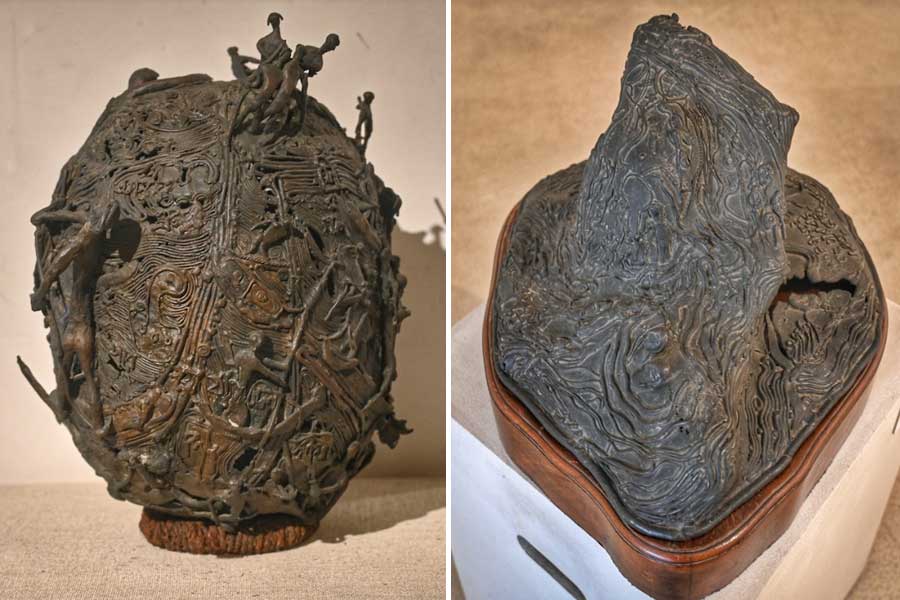
Meera Mukherjee’s bronzes were executed in a unique stylisation of folk art, south Indian techniques, and Western influences when she was studying bronze casting in Chennai
Born in 1923, she traversed two centuries, and following a European stint in the 1950s, her deep-rooted love for India pulled her back to her country where she would find her metier, living with and researching the Bastar tribes in Madhya Pradesh and studying the dokra process in Bengal. In fact, she perfected and modified to her artistic oeuvre the dokra lost wax or cire perdu technique, and her bronzes were executed in a unique stylisation of folk art, south Indian techniques, and Western influences when she was studying bronze casting in Chennai.
The paintings of Jaya Ganguly

Jaya Ganguly’s portrayed the bathos and suffering of women in a patriarchal society with subjects that were grotesque and larger than life
In stark contrast, we come across the paintings of Jaya Ganguly, stridently speaking up against a misogynistic world. The youngest of the four artists featured at the exhibition, Jaya Ganguly, who was born into a large, orthodox family in 1958 and grew up, according to art critic, the late Sovon Som, “inhibited by social taboos at every step. As a born rebel, her personal socio-cultural experiences could not allow her to look at the world with clinical detachment.” But she observed and internalised the bruised women of the red light area, in the environs of Kalighat, and with the conviction of an artist possessed to portray the bathos and the suffering of woman in a patriarchal society, she brought before us subjects that were grotesque, larger than life, in colours — first in black, and then using reds and blues for the anguished moods, using mixed media on canvas and on paper.
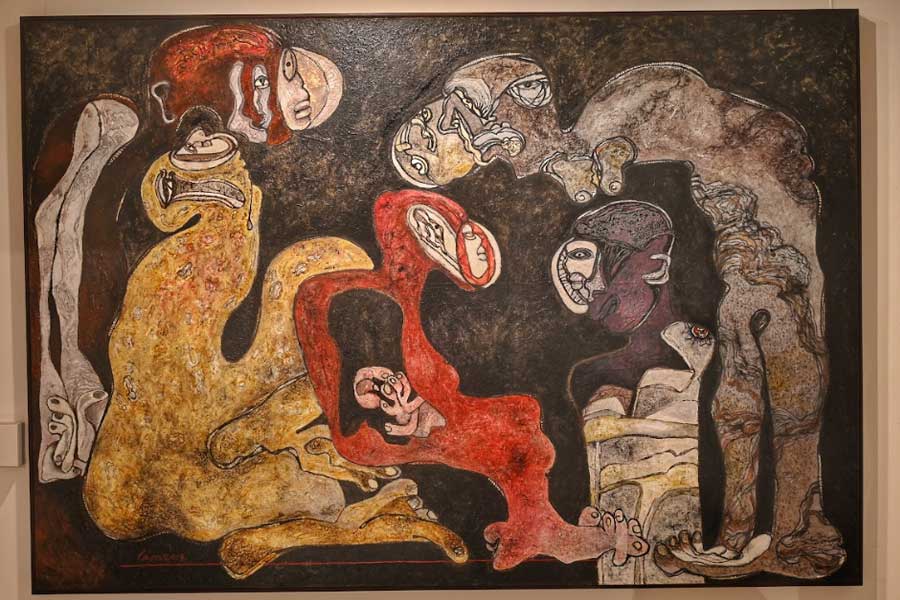
Jaya Ganguly’s work makes statements that disrupt preconceived notions through their often surreal and bizarre treatment
Jaya Ganguly herself struggled from the start, when she began to study at the Indian College of Arts and Draftsmanship, and was even allowed to pay her fees at the end of the year. She soldiered on as a freelance painter, a lone voice who continued to feel vulnerable during the Covid period, but which gave her the strength to introspect into human frailties and pictorialise them in an all-seeing uneasy repertoire of work that makes statements which disrupt our preconceived notions through their oftentimes surreal treatment, bordering on the bizarre, but richly representational of her heightened thought process where she hopes to shake people out of their complacency. We picked out a work which must be viewed from a distance, but divined close up —of a woman spread-eagled— a mixed media work from 1984 in her characteristic blues, and black with a red background.
Jogen Chowdhury’s body of work
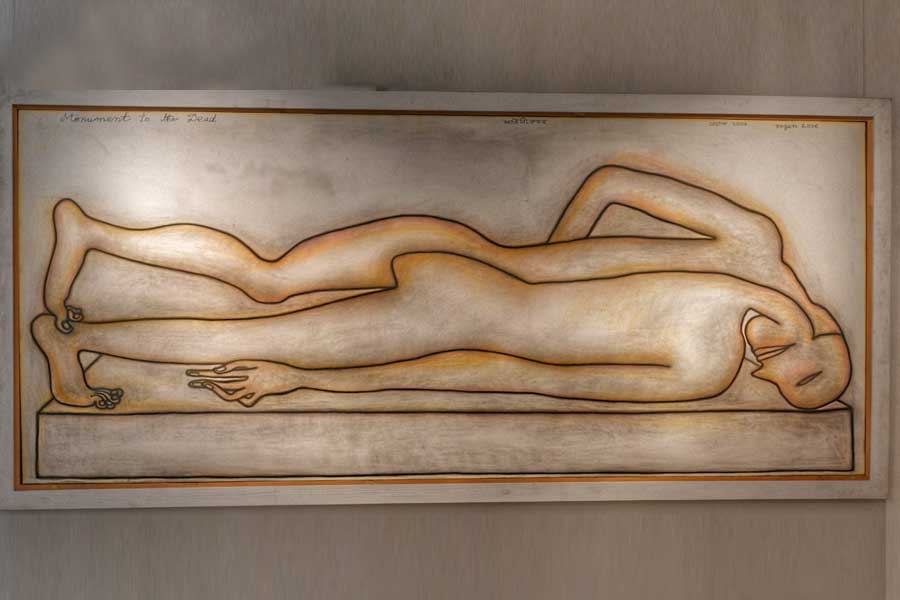
One of the pieces from the vast body of work by one of the most significant artists of the 21st century, Jogen Chowdhury
And finally, the viewer can be in sync with selections from the vast body of work of Jogen Chowdhury, one of the most significant artists of the 21st century, who is continuing to work, to encourage the next generation, creating art spaces here in Kolkata and in Santiniketan and bringing out art tomes — a vital, vibrant figure, hugely decorated, accessible and prolifically pursuing the creative oeuvre.
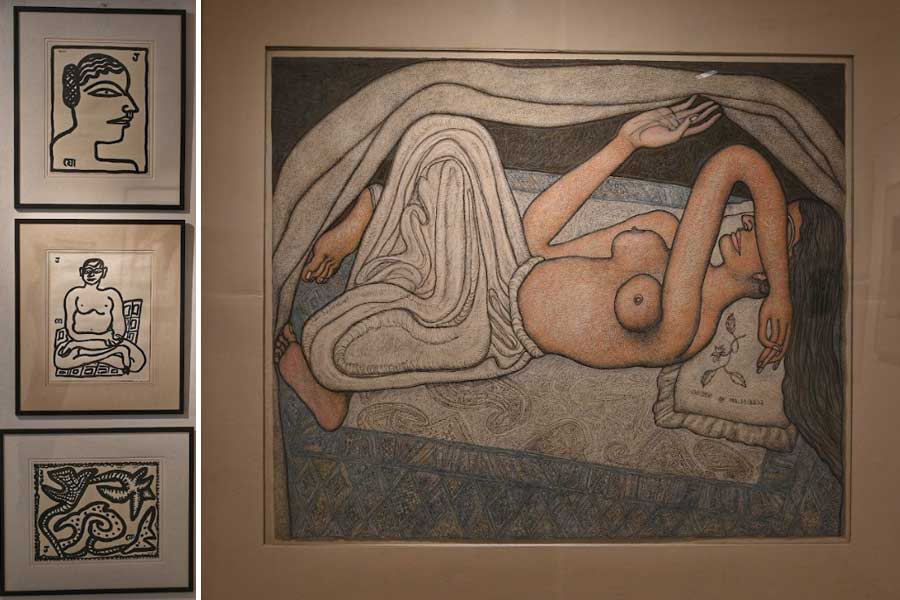
‘...he presents drawings that are a heady study of anatomical exaggerations and the fascinating felicity of the cross-hatch style that can never grow old’ — art critic Uma Nair on Jogen Chowdhury
Uma Nair, the noted art critic and curator writes about the artist: “Known for his enigmatic visions, his caressing contours and his cross hatched masterpieces Jogen Chowdhury is amongst the finest figurative and still life artists of contemporary Indian art in the 21st century. In the firmament of art practices he stands apart as a modernist who defined his own odyssey of masterpieces that celebrate paper and pen and pastel... His works straddle a corollary of contemporary conversations in the vitality and versatile power of drawings. With humble tools and ink and mixed media on paper, he presents drawings that are a heady study of anatomical exaggerations and the fascinating felicity of the cross-hatch style that can never grow old.”
All of this can be seen at the CIMA gallery, right up to his latest work done a few months ago — with his mastery of the unbroken line.
